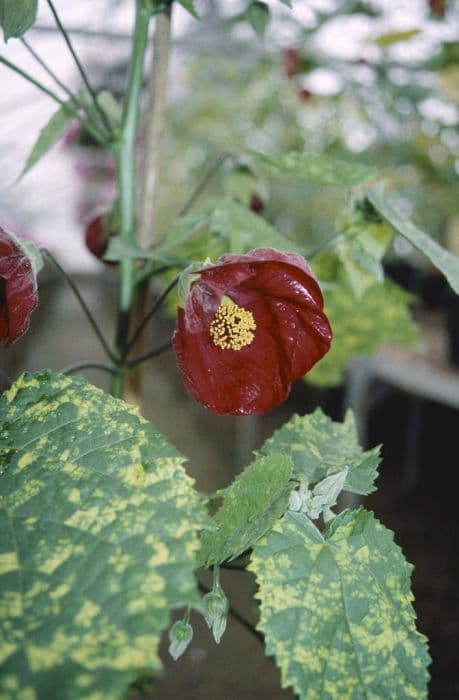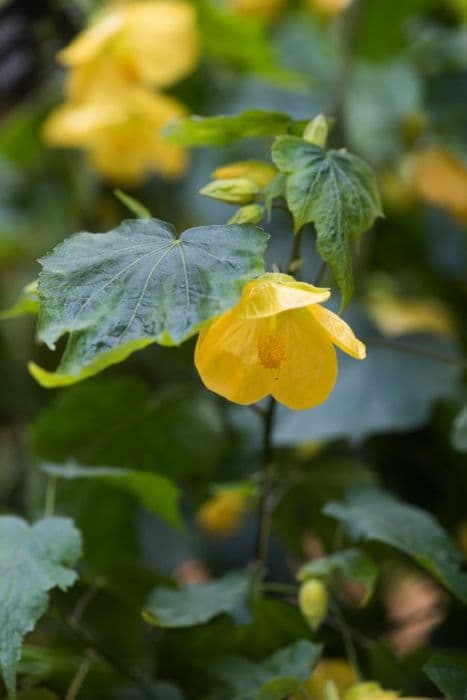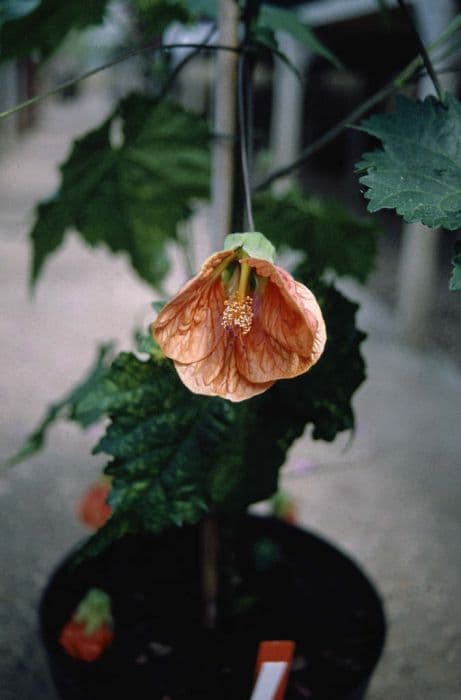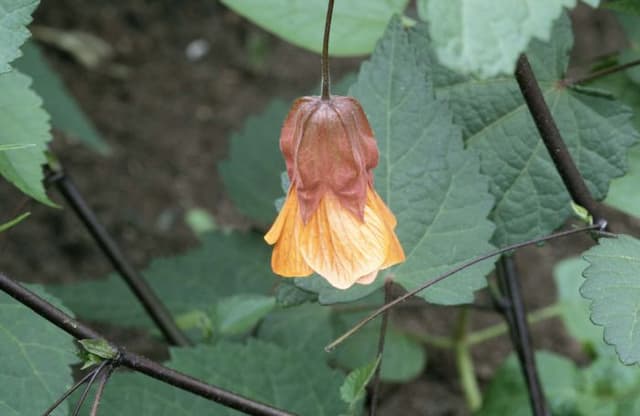Rose of Sharon [Pink Giant] Hibiscus syriacus Pink Giant = 'Flogi'
![rose of Sharon [Pink Giant]](/_next/image?url=https%3A%2F%2Fplants-admin.emdemapps.com%2Fimages%2Fplants%2F%2Fimages%2F604b63c2f36b0.png&w=3840&q=75)
ABOUT
[Pink Giant] is a bushy, upright shrub to about 2.5m with dark green, lobed leaves. Large, dark pink, single flowers with dark red centres are produced from late summer to mid-autumn
About this plant
 Names
NamesFamily
Malvaceae.
Synonyms
Rose of Sharon, Rose Althea, Shrub Althea, Hardy Hibiscus, Korean Rose, Syrian Ketmia, Pink Giant Hibiscus.
Common names
Hibiscus syriacus 'Flogi'.
 Characteristics
CharacteristicsLife cycle
Perennials
Foliage type
Deciduous
Color of leaves
Green
Flower color
Pink
Height
8-12 feet (2.4-3.7 meters)
Spread
6-10 feet (1.8-3 meters)
Plant type
Shrub
Hardiness zones
5
Native area
Asia
Benefits
 General Benefits
General Benefits- Landscape Aesthetics: Adds visual interest with large, showy pink flowers and attractive green foliage.
- Habitat Support: Provides nectar for bees and other pollinating insects, supporting local ecosystems.
- Versatility: Suitable for a range of garden designs, from formal to cottage style.
- Drought Tolerance: Once established, has a good resistance to drought, thus requiring less frequent watering.
- Low Maintenance: Generally easy to care for with minimal pruning and attention needed.
- Seasonal Interest: Flowers in summer, offering a seasonal highlight in the garden.
- Long Blooming: Has a long flowering period which can extend throughout the summer months.
- Privacy Screening: Can be used as a hedge or privacy screen due to its dense growth habit.
- Cultural Significance: In some cultures, Hibiscus flowers have symbolic meanings, such as beauty or welcome.
- Resistance to Pests: Shows good resistance to many common garden pests, reducing the need for chemical treatments.
 Medical Properties
Medical PropertiesThis plant is not used for medical purposes.
 Air-purifying Qualities
Air-purifying QualitiesThis plant is not specifically known for air purifying qualities.
 Other Uses
Other Uses- Hibiscus syriacus Pink Giant, also known as Rose of Sharon, flowers can be used in the culinary arts as an edible garnish or ingredient in salads for a splash of color.
- The blossoms of the Rose of Sharon can be fermented to create wines or teas, imparting a subtle floral flavor.
- Dried Hibiscus syriacus petals are used in potpourri blends to add aesthetic appeal and fragrance to indoor spaces.
- The plant's strong fibrous stems can be processed into natural fibers for making paper or lightweight textiles.
- Rose of Sharon wood, being quite firm, is used in woodworking for small objects or inlaid decorative elements.
- The plant can serve as a natural dye source, with the flowers yielding various shades of pink and mauve for fabrics and art materials.
- As an ornamental, the Rose of Sharon's dense growth habit makes it an excellent privacy hedge or living fence.
- The Rose of Sharon can be trained into topiary forms for garden art and design in formal landscaping settings.
- During religious ceremonies or weddings, the flowers of the Rose of Sharon are sometimes used for creating floral decorations or wreaths.
- In beekeeping, the Rose of Sharon serves as a valuable source of nectar for bees late into the summer, supporting honey production.
Interesting Facts
 Feng Shui
Feng ShuiThe Rose of Sharon is not used in Feng Shui practice.
 Zodiac Sign Compitability
Zodiac Sign CompitabilityThe Rose of Sharon is not used in astrology practice.
 Plant Symbolism
Plant Symbolism- Delicate beauty: The large, conspicuous blossoms of the Pink Giant hibiscus are often associated with a gentle and subtle beauty.
- Femininity: In many cultures, the soft pink color and the tender petals of the hibiscus represent characteristics traditionally associated with femininity, such as grace and charm.
- Inviting warmth: The hibiscus flower, with its origins in warm climates, is frequently seen as a symbol of hospitality and welcoming.
- Love and affection: The Pink Giant hibiscus can also be a symbol of romantic feelings or a gesture of deep affection towards someone.
- Carpe diem: With their short-lived blooms that last only a day or two, hibiscus flowers often symbolize the importance of seizing the moment and enjoying life's fleeting pleasures.
 Water
WaterThe Rose of Sharon 'Flogi' should be watered deeply, ensuring the soil is moist to a depth of at least 8 inches, which typically requires about 1 to 1.5 gallons of water per plant. During the first growing season, it's crucial to maintain a regular watering schedule, watering it once or twice a week, depending on rainfall and temperature. Reduce the frequency to every two weeks once the plant is established, especially in the absence of rainfall. During dry spells or extreme heat, increase watering frequency. Always check the soil moisture level before watering to prevent overwatering.
 Light
LightRose of Sharon 'Flogi' thrives best in full sun to partial shade. Ideally, it should receive at least six hours of direct sunlight daily, which promotes optimal blooming and healthy growth. If possible, situate the plant in a well-lit spot that is protected from intense afternoon sun to prevent potential leaf scorch.
 Temperature
TemperatureRose of Sharon 'Flogi' is hardy and can withstand a range of temperatures, typically thriving in zones 5 through 8. The ideal growing temperatures are between 60 to 80 degrees Fahrenheit. However, it can survive minimum winter temperatures down to around -20 degrees Fahrenheit and can withstand summer heat above 90 degrees Fahrenheit provided it has adequate moisture.
 Pruning
PruningPrune Rose of Sharon 'Flogi' to maintain shape and promote vigorous growth, removing any dead or damaged branches. The best time to prune is late winter or early spring before new growth begins. The plant can be pruned annually to encourage bushier growth and more flowers. Deadheading spent blooms throughout the growing season can also promote further flowering.
 Cleaning
CleaningAs needed
 Soil
SoilThe Rose of Sharon (Hibiscus syriacus 'Flogi') thrives best in well-draining, loamy soil enriched with organic matter. A pH level of 6.0 to 7.5 is ideal. A mix of two parts garden soil, one part peat moss, and one part perlite or sand can create the optimal growing medium.
 Repotting
RepottingRose of Sharon generally does not require frequent repotting and can be repotted every 3-5 years, or as necessary when rootbound.
 Humidity & Misting
Humidity & MistingRose of Sharon tolerates a wide range of humidity levels but prefers a moderate to high humidity environment for optimal growth.
 Suitable locations
Suitable locationsIndoor
Ensure bright light, pot in well-draining soil.
Outdoor
Plant in full sun, enrich soil, water well.
Hardiness zone
5-8 USDA
 Life cycle
Life cycleThe Hibiscus syriacus Pink Giant ('Flogi'), commonly known as the Rose of Sharon, begins its life cycle as a seed, which, once sown and germinated in spring, sprouts into a small seedling. The seedling develops into a young plant with characteristic leaves, and as it matures, it undergoes vegetative growth, producing woody stems and more foliage. During its growing season, typically in summer, the Rose of Sharon's distinctive large pink flowers blossom, attracting pollinators for sexual reproduction. Following pollination, the plant forms dry fruits (capsules) that contain seeds, which are dispersed by wind or wildlife, completing its reproductive cycle. The Rose of Sharon can also spread asexually through cuttings or layering. As a perennial, it enters a period of dormancy in winter, losing its leaves, only to regrow them in the spring and start the cycle anew.
 Propogation
PropogationPropogation time
Spring-Early Summer
Propogation: The Rose of Sharon 'Pink Giant' or Hibiscus syriacus 'Flogi' is typically propagated through semi-hardwood cuttings during late summer. The most popular method involves taking a cutting of about 4 to 6 inches (10 to 15 centimeters) in length from a healthy, disease-free branch. The leaves on the lower half of the cutting should be removed and the cut end can be dipped in rooting hormone to encourage root development. This treated cutting is then placed in a well-draining potting mix and kept moist under high humidity, often with the aid of a plastic covering to retain moisture. Roots generally form within a few weeks, after which the young plant can be gradually acclimatized to less humid conditions before being planted out in the garden in the following spring.





![Abutilon [Yellow Trumpet]](/_next/image?url=https%3A%2F%2Fplants-admin.emdemapps.com%2Fimages%2Fplants%2F%2Fimages%2F604b5caa8b4fb.png&w=640&q=75)


